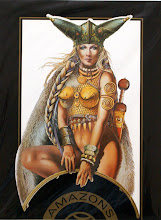Better known as Bill or Billy Wakefield, George William Wakefield was one of the stalwarts of the Amalgamated Press story papers and comics of the early 20th century.
Born in Hoxton, London, on 13 November 1887, he was the son of George Thomas Wakefield, a house decorator, and his wife Maria (nee Thorpe), who worked as a charwoman. He was baptized at St Leonard's, Shoreditch on 11 December 1887. Bill grew up in Bethnal Green, his family including a younger sister, Nellie, and was educated locally before winning a scholarship to the Camberwell School of arts and Crafts.
Wakefield began submitting cartoons of Edwardian papers and sold his first to Ally Sloper's Half Holiday in 1906; from 1907 he began appearing regularly in Scraps and other papers published by James Henderson. His earliest comic strip, "Baron de Cuff and the Hon. Samuel Shiney" appeared in The Comic Companion (a supplement of You and I magazine) in 1908, followed by "Tap Room Tales" in Scraps.
Until he was established, Wakefield was also a part-time boxer: big (5' 8 1/2", 158 pounds) and thickset he fought amateur heavyweight matches and exhibitions at funfairs. Despite his size and ham-like fists, his speciality soon began to develop: young, sweet but sexy girls for serials in the saucy magazine Photo Bits. Introduced to Frederick Caldwell of the Amalgamated Press, Wakefield found himself drawing flappers for Caldwell's story paper Fun & Fiction ("Gertie Goodsort and her Little Sister Sue"), Merry & Bright ("Gertie and Gladys"), Firefly ("Gertie Gladeyes") and The Favourite Comic ("Flossie and Phyllis, the Fascinating Flappers"). At the same time he was drawing cherub-faced young lads for The Penny Wonder in 1912.
Wakefield married Anne Beatrice Cordwell in 1908 and began raising a family in Stoke Newington with the birth of Poppy Marie (later Bott, 1909-1996) and Terence George (1911-1989).
During the Great War, Wakefield enlisted in February 1916 to serve with the 6th Battalion City of London Rifles and was mobilized in June. However, he was discharged in November 1917 suffering from chronic gastritis and duodenal ulcers — a condition he had suffered from prior to his war service — which would require hospital treatment. He returned to drawing comics with "Carrie the Girl Chaplin" in Merry & Bright.
In 1918, he began a long association with The Boys' Friend illustrating the "Rookwood" stories of Owen Conquest (Charles Hamilton) until 1926. It was, however, in the pages of Film Fun that he made his greatest mark, his talents for capturing a likeness without turning it into a caricature setting the style for Fred Cordwell's new paper when it was launched in 1920. Wakefield's contributions featuring stars of the silent movies ranged from child star Baby Marie Osborne to comedian Ben Turpin. The paper proved so popular that Kinema Comic was launched four months later, with Wakefield contributing "Fatty Arbuckle", "Ford Sterling", "Larry Semon" and "Walter Forde" to the new title.
Apart from a number of sportsmen given similar treatment in the pages of the short-run Sports Fun, and "The Jolly Rover" strip for the cover of My Favourite, Wakefield's main output continued to be for Film Fun, where he drew the comical adventures of Jackie Coogan, Wesley Barry and Grock (Charles Adrien Wettach), the "king of clowns", before achieving his most long-lasting success drawing the adventures of Laurel and Hardy, which he drew from 1930 until his death.
Other sets in Film Fun in the 1930s included Joe E. Brown, Wheeler and Woolsey, Shirley Temple, George Formby, Max Miller and Lupino Lane. Wakefield also drew story paper headings for Bullseye and Surprise, contributed complete dramatic adaptations of movies to the early issues of Film Picture Stories and humour strips "Chubby and Chirpy" and "The Flighty Pranks Freddie Flip and Uncle Bunkle" to Sparkler and "Teacher Trotter" to Comic Cuts.
Wakefield died in Norwich Hospital in Norfolk on 12 May 1942, aged 54. His influence on the style of British comics was profound, with artists on Film Fun — then the best-selling comic in the UK — told to work in his style. Some of his sets, including "Laurel and Hardy", were continued after his death by his son, Terry.
Examples of George Wakefield's artwork can be found for sale at the Illustration Art Gallery.
Subscribe to:
Post Comments (Atom)




















No comments:
Post a Comment